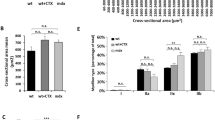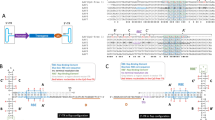Abstract
One of the major hurdles facing the application of adenoviral gene transfer to skeletal muscle is the maturation-dependent transduction of muscle myofibers. It was recently proposed that the viral receptors (Coxsackie and adenovirus receptor (CAR) and the integrins αvβ3/β5) play a major role in the poor adenoviral transduction of mature myofibers. Here we report the findings of morphological studies designed to determine experimentally the role of receptors in the adenoviral transduction of mature myofibers. First, we observed that the expression of both attachment and internalization receptors did not change significantly during muscle development. Second, when an extended tropism adenoviral vector (AdPK) that attaches to heparan sulfate proteoglycan (HSP) is used, a significant reduction of adenoviral transduction still occurs in mature myofibers despite HSP's high expression in mature skeletal muscle fibers. Third, when the adeno-associated virus (AAV) is used, which also utilizes HSP as a viral receptor, muscle fibers at different maturities can be highly transduced. Fourth, the pre-irradiation of the skeletal muscle of newborn mice to inactivate myoblasts dramatically decreased the transduction level of Ad and AdPK, but had no effect on AAV-mediated viral transduction of immature myofibers. These results taken together suggest that the viral receptor(s) is not a major determinant in maturation-dependent adenoviral transduction of myofibers.
This is a preview of subscription content, access via your institution
Access options
Subscribe to this journal
Receive 12 print issues and online access
$259.00 per year
only $21.58 per issue
Buy this article
- Purchase on Springer Link
- Instant access to full article PDF
Prices may be subject to local taxes which are calculated during checkout










Similar content being viewed by others
References
Beauchamp JR, Morgan JE, Pagel CN, Partridge TA . Dynamics of myoblast transplantation reveal a discrete minority of precursors with stem cell-like properties as the myogenic source J Cell Biol 1999 144: 1113–1122
Beauchamp JR, Pagel CN, Partridge TA . A dual-marker system for quantitative studies of myoblast transplantation in the mouse Transplantation 1997 63: 1794–1797
Guerette B et al. Immunosuppression with monoclonal antibodies and CTLA4-Ig after myoblast transplantation in mice Transplantation 1996 62: 962–967
Gussoni E, Blau HM, Kunkel LM . The fate of individual myoblasts after transplantation into muscles of DMD patients Nat Med 1997 3: 970–977
Karpati G et al. Myoblast transfer in Duchenne muscular dystrophy Ann Neurol 1993 34: 8–17
Mendell JR et al. Myoblast transfer in the treatment of Duchenne's muscular dystrophy New Engl J Med 1995 333: 832–838
Tremblay JP et al. Myoblast transplantation between monozygotic twin girl carriers of Duchenne muscular dystrophy Neuromusc Disord 1993 3: 583–592
Huard J et al. Gene transfer into skeletal muscles by isogenic myoblasts Hum Gene Ther 1994 5: 949–958
Qu Z et al. Development of approaches to improve cell survival in myoblast transfer therapy J Cell Biol 1998 142: 1257–1267
Partridge TA et al. Conversion of mdx myofibres from dystrophin-negative to -positive by injection of normal myoblasts Nature 1989 337: 176–179
Wolff JA et al. Long-term persistence of plasmid DNA and foreign gene expression in mouse muscle Hum Mol Genet 1992 1: 363–369
Davis HL, Jasmin BJ . Direct gene transfer into mouse diaphragm FEBS Lett 1993 333: 146–150
Doh SG et al. Spatial-temporal patterns of gene expression in mouse skeletal muscle after injection of lacZ plasmid DNA Gene Therapy 1997 4: 648–663
Vitiello L et al. Condensation of plasmid DNA with polylysine improves liposome-mediated gene transfer into established and primary muscle cells Gene Therapy 1996 3: 396–404
Mir LM et al. High-efficiency gene transfer into skeletal muscle mediated by electric pulses Proc Natl Acad Sci USA 1999 96: 4262–4267
Dunckley MG et al. Retroviral-mediated transfer of a dystrophin minigene into mdx mouse myoblasts in vitro FEBS Lett 1992 296: 128–134
Dunckley MG, Wells DJ, Walsh FS, Dickson G . Direct retroviral-mediated transfer of a dystrophin minigene into mdx mouse muscle in vivo Hum Mol Genet 1993 2: 717–723
Salvatori G et al. Retroviral vector-mediated gene transfer into human primary myogenic cells leads to expression in muscle fibers in vivo Hum Gene Ther 1993 4: 713–723
Miller DG, Adam MA, Miller AD . Gene transfer by retrovirus vectors occurs only in cells that are actively replicating at the time of infection Mol Cell Biol 1990 10: 4239–4242
van Deutekom JCT et al. Implications of maturation for viral gene delivery to skeletal muscle Neuromusc Disord 1998 8: 135–148
Huard J et al. Gene transfer to muscle using herpes simplex virus-based vectors Neuromusc Disord 1997 7: 299–313
Huard J et al. LacZ gene transfer to skeletal muscle using a replication-defective herpes simplex virus type 1 mutant vector Hum Gene Ther 1997 8: 439–452
Li J et al. rAAV vector-mediated sarcogylcan gene transfer in a hamster model for limb girdle muscular dystrophy Gene Therapy 1999 6: 74–82
Pruchnic R et al. The use of adeno-associated virus to circumvent the maturation dependent viral transduction of muscle fibers Hum Gene Ther 2000 11: 521–536
Clark KR, Sferra TJ, Johnson PR . Recombinant adeno-associated viral vectors mediate long-term transgene expression in muscle Hum Gene Ther 1997 8: 659–669
Fisher KJ et al. Recombinant adeno-associated virus for muscle directed gene therapy Nat Med 1997 3: 306–312
Xiao X, Li J, Samulski RJ . Efficient long-term gene transfer into muscle tissue of immunocompetent mice by adeno-associated virus vector J Virol 1996 70: 8098–8108
Haecker SE et al. In vivo expression of full-length human dystrophin from adenoviral vectors deleted of all viral genes Hum Gene Ther 1996 7: 1907–1914
Kochanek S et al. A new adenoviral vector: replacement of all viral coding sequences with 28 kb of DNA independently expressing both full-length dystrophin and beta-galactosidase Proc Natl Acad Sci USA 1996 93: 5731–5736
Chen HH et al. Persistence in muscle of an adenoviral vector that lacks all viral genes Proc Natl Acad Sci USA 1997 94: 1645–1650
Feero WG et al. Viral gene delivery to skeletal muscle: insights on maturation-dependent loss of fiber infectivity for adenovirus and herpes simplex type 1 viral vectors Hum Gene Ther 1997 8: 371–380
Ragot T et al. Adenovirus-mediated transfer of a human dystrophin gene to skeletal muscle of mdx mouse Gene Therapy 1994 1 (Suppl 1): S53–S54
Vincent N et al. Long-term correction of mouse dystrophic degeneration by adenovirus-mediated transfer of a minidystrophin gene Nat Genet 1993 5: 130–134
Acsadi G et al. A differential efficiency of adenovirus-mediated in vivo gene transfer into skeletal muscle cells of different maturity Hum Mol Genet 1994 3: 579–584
Acsadi G et al. Cultured human myoblasts and myotubes show markedly different transducibility by replication-defective adenovirus recombinants Gene Therapy 1994 1: 338–340
van Deutekom JCT, Hoffman E, Huard J . Muscle maturation: implications for gene therapy Mol Med Today 1998 4: 214–220
Yurchenco PD . Assembly of basement membranes Ann NY Acad Sci 1990 580: 195–213
Bergelson JM et al. Isolation of a common receptor for Coxsackie B viruses and adenoviruses 2 and 5 Science 1997 275: 1320–1323
Tomko RP, Xu R, Philipson I . HCAR and MCAR: the human and mouse cellular receptors for subgroup C adenoviruses and group B coxsackieviruses Proc Natl Acad Sci USA 1997 94: 3352–3356
Nalbantoglu J, Pari G, Karpati G, Holland PC . Expression of the primary coxsackie and adenovirus receptor is downregulated during skeletal muscle maturation and limits the efficacy of adenovirus-mediated gene delivery to muscle cells Hum Gene Ther 1999 10: 1009–1019
Fechner H et al. Expression of coxsackie adenovirus receptor and alphav-integrin does not correlate with adenovector targeting in vivo indicating anatomical vector barriers Gene Therapy 1999 6: 1520–1535
Huard J et al. The basal lamina is a physical barrier to herpes simplex virus-mediated gene delivery to mature muscle fibers J Virol 1996 70: 8117–8123
van Deutekom JCT et al. Extended tropism of an adenoviral vector does not circumvent the maturation-dependent transducibility of mouse skeletal muscle J Gene Med 1999 1: 393–399
Worgall S et al. Free cholesterol enhances adenoviral vector gene transfer and expression in CAR-deficient cells Mol Ther 2000 1: 39–48
Hynes RO . Integrins: versatility, modulation, and signaling in cell adhesion Cell 1992 69: 11–25
Sanes JR . The extracellular matrix. In: Engel EG, Banker BQ (eds) Myology McGraw Hill: New York 1986 155–176
Engel WK, Karpati G . Impaired skeletal muscle maturation following neonatal neurectomy Dev Biol 1968 17: 713–723
Pierschbacher MD, Ruoslahti E . Cell attachment activity of fibronectin can be duplicated by small synthetic fragments of the molecule Nature 1984 309: 30–33
Wickham TJ, Roelvink PW, Brough DE, Kovesdi I . Adenovirus targeted to heparan-containing receptors increases its gene delivery efficiency to multiple cell types Nat Biotechnol 1996 14: 1570–1573
Wickham TJ, Carrion ME, Kovesdi I . Targeting of adenovirus penton base to new receptors through replacement of its RGD motif with other receptor-specific peptide motifs Gene Therapy 1995 2: 750–756
Wickham TJ et al. Increased in vitro and in vivo gene transfer by adenovirus vectors containing chimeric fiber proteins J Virol 1997 71: 8221–8229
Bouri K et al. Polylysine modification of adenoviral fiber protein enhances muscle cell transduction Hum Gene Ther 1999 10: 1633–1640
Summerford C, Bartlett JS, Samulski RJ . AlphaVbeta5 integrin: a co-receptor for adeno-associated virus type 2 infection Nat Med 1999 5: 78–82
Kovesdi I, Brough DE, Bruder JT, Wickham TJ . Adenoviral vectors for gene transfer Curr Opin Biotechnol 1997 8: 583–589
Xiao X, Li J, Samulski RJ . Production of high-titer recombinant adeno-associated virus vectors in the absence of helper adenovirus J Virol 1998 72: 2224–2232
Rosenblatt JD, Lunt AI, Parry DJ, Partridge TA . Culturing satellite cells from living single muscle fiber explants In Vitro Cell Dev Biol Anim 1995 31: 773–779
Sambrook J, Fritsch EF, Maniatis T . Assay for β-galactosidase in extracts of mammalian cells. In: Molecular Cloning: A Laboratory Manual, 2nd edn. Cold Spring Harbor Laboratory Press: New York 1989 pp 16.66–16.67.
Acknowledgements
This work was supported by the Parent Project (USA), the Muscular Dystrophy Association (USA), the National Institutes of Health (NIH PO1 AR 45925–01), and the William F and Jean W Donaldson Chair at Children's Hospital of Pittsburgh. The authors thank Jim Cummins, Marcelle Pellerin and Arvydas Usas for technical contributions and Lauren Rudick, Dana Och and Megan Mowry for assistance with the manuscript. We thank Dr JM Bergelson of Children's Hospital of Philadelphia for kindly providing the CAR antibody.
Author information
Authors and Affiliations
Rights and permissions
About this article
Cite this article
Cao, B., Pruchnic, R., Ikezawa, M. et al. The role of receptors in the maturation-dependent adenoviral transduction of myofibers. Gene Ther 8, 627–637 (2001). https://doi.org/10.1038/sj.gt.3301425
Received:
Accepted:
Published:
Issue Date:
DOI: https://doi.org/10.1038/sj.gt.3301425



